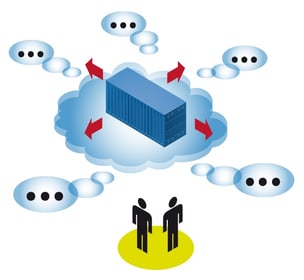How Cloud Computing Could Impact Logistics 4.0
Brian Hoey - April 02, 2020

 In one sense, transitioning to a full-fledged Logistics 4.0 system is always going to be more of a challenge than making Industry 4.0 a reality. Yes, Industry 4.0 requires big investments in carefully-chosen IT infrastructure and a strong commitment to visibility and connectivity, but the purview of this technological revolution is mostly limited to the factory floor—i.e. a physical space that you, as a manufacturer, have access to and control over. With logistics, this limit doesn’t exist—instead, you’re trying to gather data from objects that are in motion all around the world, from shipping containers to trucks to the forklifts in your partners’ warehouses.
In one sense, transitioning to a full-fledged Logistics 4.0 system is always going to be more of a challenge than making Industry 4.0 a reality. Yes, Industry 4.0 requires big investments in carefully-chosen IT infrastructure and a strong commitment to visibility and connectivity, but the purview of this technological revolution is mostly limited to the factory floor—i.e. a physical space that you, as a manufacturer, have access to and control over. With logistics, this limit doesn’t exist—instead, you’re trying to gather data from objects that are in motion all around the world, from shipping containers to trucks to the forklifts in your partners’ warehouses.
As you can imagine, this is no mean feat. Logistics managers, shippers, and freight forwarders are likely going to need every tool at their disposal to make Logistics 4.0 a reality. This means implementing things like smart containers and smart pallets that can send data back to a centralized transport management system (TMS). It also means powerful analytics integrations that make it possible to reroute shipments on the fly—with potentially limited human intervention. But could it also mean switching to the cloud for hosting data and software solutions? That’s exactly the question we’ll be exploring today.
The Industry 4.0 Cloud
At its simplest level, Industry 4.0 can be described as the “growing combination of traditional manufacturing and industrial platforms and practices with the latest smart technology.” While there are any number of technologies typically associated with this paradigm—from the IoT (internet of things) to AI and Machine Learning to robotics—there is an extent to which the cloud has the power to form the backbone of any deployment of new technology in the global value chain. To wit, in a recent Oracle report surveying 1,200 technology decision-makers in midsize and large companies, “60% said an integrated cloud approach will unlock the potential of disruptive technologies, such as robotics and artificial intelligence.”
Why does the cloud seem like such an attractive option for powering these new, Industry 4.0-critical deployments? For starters, it offers a high degree of flexibility and scalability. In contrast to on-premise storage and software hosting—which could require expensive IT projects to add more storage capacity or processing power—the cloud lets you pay as you go, using as much or as little capacity as you need at any given time. This can help you to achieve a modicum of budget certainty, yes, but it can also help you to navigate unexpected spikes in demand or other scenarios where you might need more computing power than usual. As you potentially beef up your IT infrastructure with new apps and devices, the cloud can make it easy to scale up your capacity while integrating a variety of different data sources (due to the cloud’s accessible, decentralized nature).
Powering Supply Chain Analytics
If the cloud can add value for Industry 4.0 deployments by building in flexibility and easy integration, it stands to reason that it could add similar value for Logistics 4.0. After all, Logistics 4.0 has connectivity, flexibility, and visibility requirements that are easily as stringent as those necessary for Industry 4.0. To create a smart network of pallets, containers, trucks, and even entire ports that can be accessed and analyzed on the fly in order to create optimal shipping routes and improve on-time performance, you’ll need the right tools powered by the right technology. More specifically, you’ll need to build in real-time analytics functionality on top of all of the data that you’re collecting with your sensors and IT integrations. In this way, you can begin to move beyond reactive plans based on limited data and predictive insight.
Under these conditions, machine learning has the power to help you create proactive plans that account for more information than a human planner could possibly grapple with. Is there a redundant cross-dock in your transportation network? Advanced supply chain analytics can help you figure that out. Interested in making dynamic changes to your shipping routes based on traffic and market conditions rather than utilizing static routes every time? AI can help with that. Looking for ways to manage logistics disruptions in real-time? Let machine learning algorithms turn real-time data into re-planning analyses.
While it’s certainly possible to run analytics processes like these using locally-hosted software, this is a use case for which the cloud is particularly well suited. Not only does it give users flexible capacity in terms of computing power, it’s also designed around connected, decentralized processes (like those that define the global supply chain). At the end of the day, this—the ability to centralize analytics while decentralizing data collection and accessibility—might represent the biggest impact that the cloud will have on Logistics 4.0 systems.
Logistics 4.0 Hurdles
While the cloud on the whole has the potential to be a key driver of Logistics 4.0 innovations, it’s not sufficient in and of itself to revolutionize the way we move goods around the globe. Why? Because, like any other server, the cloud is only as valuable as the software it runs and the data it stores. So, for logistics managers or logistics providers who are considering making the switch to the cloud, it’s worth thinking about how best to set your IT infrastructure up for success. To that end, here a few hurdles that you’ll need to overcome in order to maximize the impact of the cloud on your value chain:
- Data silos: the cloud can help root these out, but you still need to commit to silo reduction in order to get the most value out of your data.
- Shadow IT: likewise, the cloud can help with software integration, but you first have to get operational buy-in and choose appropriate software solutions.
- Poor supplier integration: even if your cloud-based ERP or other software system has the power to internetwork disparate solutions, you’ll need buy-in from suppliers to affect information sharing arrangement.
- Poor execution: Do your logistics plans tend to get executed successfully, or does something often get lost in translation? To stave off disruptions and breakdowns, you’ll need to make sure that your planners are actually empowered to get their plans enacted by the relevant stakeholders.
At this point, it’s too early to say exactly what impact the cloud is going to have on emerging trends like Logistics 4.0 across the entire industry—but that doesn’t mean we can’t imagine a cloud-powered logistics chain might look like. If you’re able to overcome the hurdles listed above, the impact of the cloud on your own supply chain accuracy and performance could be game-changing.
LATEST POSTS
- Understand Why Production Planning Needs Specialized Solutions
- Understand Circular Economy in The Manufacturing Industry
- How Can Industry 4.0 IT Integration Be Achieved Smoothly?
- The Significance of Order Sequencing in Discrete Manufacturing
- How to improve your Supply Chain Management: The Power of Control Towers



